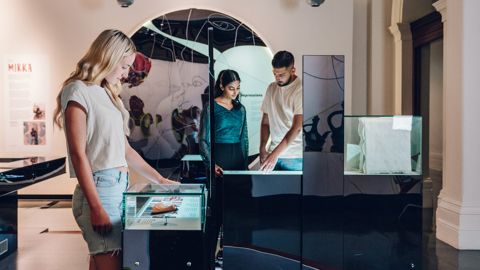Did you know...?
- Phar Lap was born in Timaru, New Zealand on October 4th, 1926.
- One legendary race horse in Phar Lap’s pedigree was Carbine, who won the 1890 Melbourne Cup.
- Phar Lap was bought by businessman David Davis after trainer Harry Telford picked him from a New Zealand racehorse catalogue. They didn’t actually see him until he arrived in Australia as they purchased him at auction sight unseen.
- When Phar Lap arrived in Australia, Harry Telford became his trainer. He regularly trained Phar Lap by running him up the sand hills around Cronulla beach.
- His strapper was Tommy Woodcock who would call Phar Lap ‘Bobby’ and would often feed him lumps of sugar from his pocket. He later became Phar Lap’s trainer when he went to America.
- Phar Lap means ‘lightning’ in Thai language.
- Phar Lap grew to become a giant 17.1 hands high.
- Phar Lap’s first race was at Rosehill and was a dismal failure, he came last.
- In his career Phar Lap was in fifty-one races and won thirty-seven of them.
- At one stage Phar Lap won fourteen races in a row.
- Most of his winning races were with the jockey Jim Pike. Jim Pike and Phar Lap had one of the greatest partnerships in Australian sport, in fact they only lost two races together.
- Phar Lap was the only horse to have been favourite for the Melbourne Cup three years in a row.
- Phar Lap only won one Melbourne Cup – in 1930.
- Phar Lap so dominated Australian racing in this era that the Victorian Racing Club altered the conditions of some weight for age races to try and curb his winning streak.
- Someone tried to shoot Phar Lap just before he was due to race in the 1930 Melbourne Cup. One morning while Tommy Woodcock was exercising him around the back streets of Glen Huntly, shots were fired at Phar Lap by a passing car but luckily the bullets missed him.
- Phar Lap was hidden on a farm near Geelong until the day of the Melbourne Cup. Unfortunately the horse float taking him that morning to Flemington broke down and Phar Lap arrived late, forty minutes before the Melbourne Cup was due to start.
- The 1931 Futurity Stakes at Caulfield is often cited as Phar Lap’s greatest achievement. He carried the maximum weight allowed for the race, the track was heavy with rain and he gave his opponents a ninety-one metre head start before taking the lead and winning the race.
- Phar Lap’s last race was in Tijuana, Mexico, at the race track at Agua Caliente, which he won.
- During that race he was recovering from an injury to his hoof and was carrying his winter coat in their summer heat. His win broke a track record and made headlines in Australia and America.
- Soon after an offer came from MGM for Phar Lap to star in a movie.
- Sadly Phar Lap died in mysterious circumstances soon after, on April 5th, 1932 at Menlo Park in California.
- The Australian Prime Minister, Joseph Lyons, called his death a ‘great sporting tragedy’.
- At the time, many felt that Phar Lap was poisoned by underworld figures in the US, although nothing was ever proven.
- In recent times experts have examined hair samples from Phar lap before and after his death and discovered there was arsenic in the hairs that had come from his body, enough to have killed him. However how it got there is still a mystery.
- Phar Lap’s heart is on display at the National Museum in Canberra, his skeleton is on display at the Te Papa Museum in Wellington, New Zealand and his hide is at the Melbourne Museum for everyone to see.








